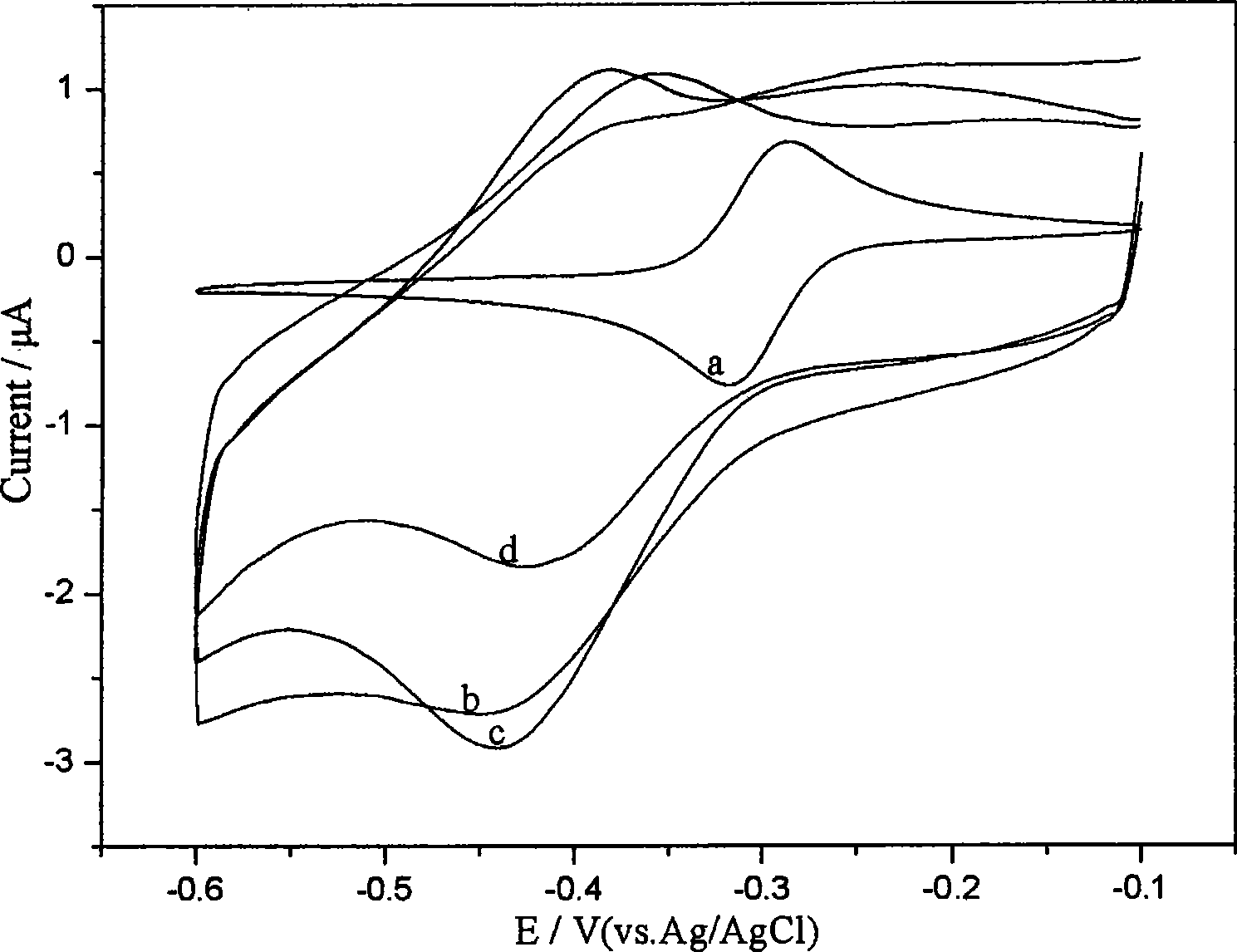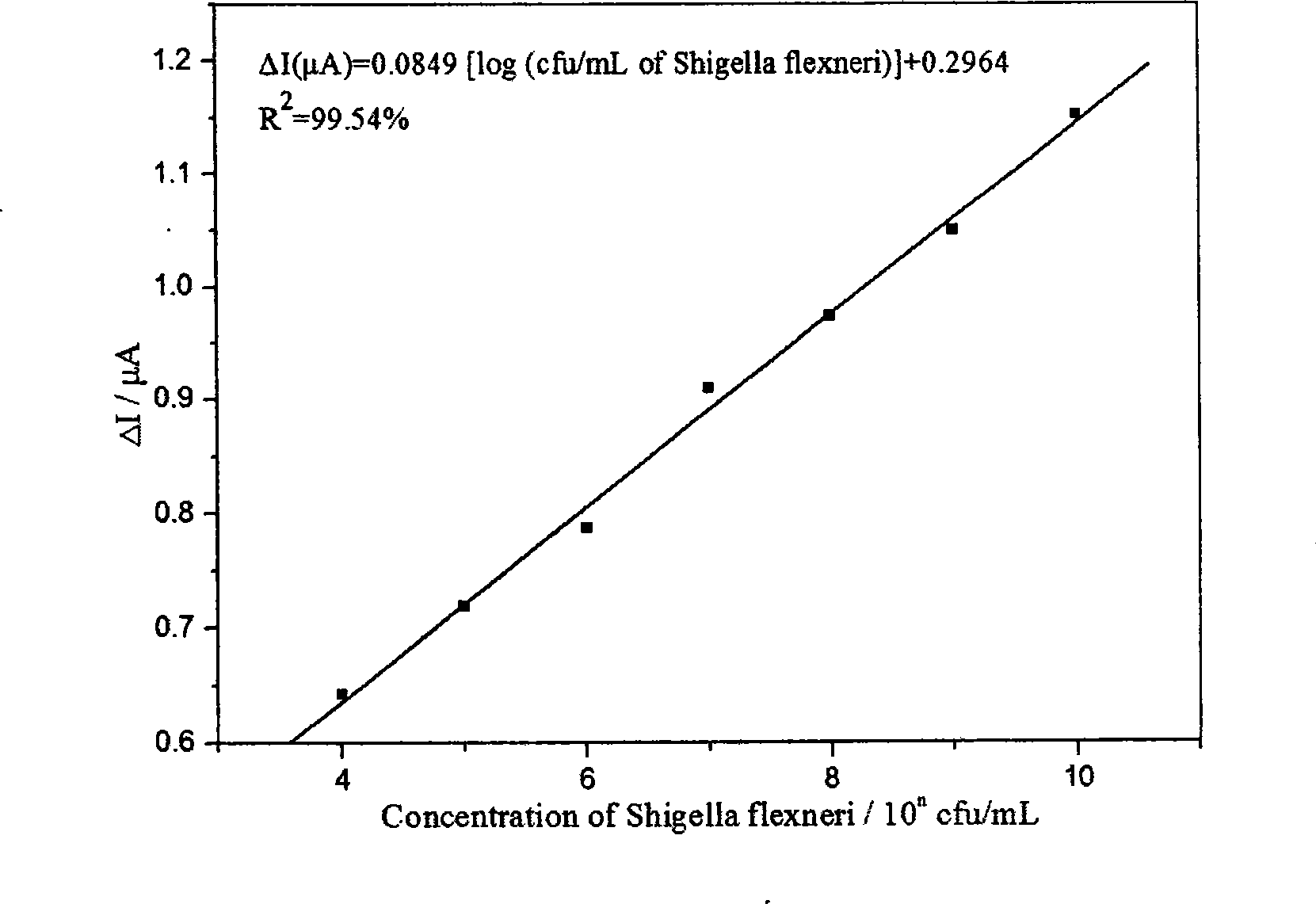Enzyme immunosensor for detecting Shigella species and its preparation method and application
A Shigella and enzyme immunization technology, applied in instruments, measuring devices, scientific instruments, etc., can solve the problems of complex detection process, long detection time, human and environmental hazards, etc., and achieve simplified preparation steps, short response time, highly specific effect
- Summary
- Abstract
- Description
- Claims
- Application Information
AI Technical Summary
Problems solved by technology
Method used
Image
Examples
Embodiment 1
[0040] Example 1: Preparation of Enzyme Immunosensor
[0041] Ultrasonic dispersion of 2.0 mg of multi-walled carbon nanotubes in 10 mL of chitosan sol with a mass volume percentage of 1%, to obtain a uniform multi-walled carbon nanotube-chitosan composite;
[0042] Fully mix the multi-walled carbon nanotube-chitosan complex with the anti-Shigella flexneri antibody solution labeled with horseradish peroxidase in equal volumes; place the mixture at 4°C for 12 hours;
[0043] Take 3 μL of the above mixed solution and apply it dropwise on the surface of the working electrode of the disposable screen-printed electrode, and place it at room temperature for 3-5 hours to dry and form a film;
[0044] Soak the coated immune electrode in PBS phosphate buffer solution containing 0.2% BSA (bovine serum albumin), place it at 4°C for 1 hour, rinse it with double distilled water, and remove chitosan that is not firmly bound to the electrode Antibody membrane and blocking non-specific adsor...
Embodiment 2
[0046] Embodiment 2: the method for detecting Shigella
[0047] The enzyme immunosensor described in Example 1 was connected to the electrochemical workstation (CHI 1030A) through wires, and the computer was connected to the electrochemical workstation.
[0048] Put the enzyme immunosensor into the electrolytic cell, and the detection bottom solution of the electrolytic cell contains 0.6mmol / L H 2 o 2 And the acetate buffer solution of 1.0mmol / L thionine, pH value is 7.0. Set the CV measurement parameters of the electrochemical workstation: the potential scanning range is -0.1~-0.6V, the scanning rate is 0.1V / s, apply voltage to the working electrode of the enzyme immunosensor, and measure the current value Ip1 between the auxiliary electrode and the working electrode is 1.946μA.
[0049] Anal swabs from patients with vomiting and diarrhea were taken aseptically, after enrichment, isolation and culture, centrifuged at 8000r / min for 5min, the lower layer of bacteria sludge w...
Embodiment 3
[0052] Using the immunosensor described in Example 1 and the detection method of Shigella in Example 2, different concentrations of Shigella were measured, and a standard current-concentration curve was made, specifically using the Shigella flexneri standard sample preparation 10 10 cfu / mL in PBS solution and serially diluted to 10 4 cfu / mL. Create a standard curve, such as figure 2 shown. Its detection limit: 10 4 cfu / mL; linear interval: 10 4 cfu / mL~10 10 cfu / mL; linear correlation coefficient: R 2 = 99.54%.
[0053] Take the anal swabs of patients with vomiting and diarrhea by aseptic operation. The sample processing and detection methods are the same as in Example 2. Finally, ΔI=0.9312 μA is obtained. Compared with the standard current-concentration curve, the Shiga flexneri contained in the tested sample is calculated. Bacteria concentration is 3×10 7 cfu / mL.
PUM
 Login to View More
Login to View More Abstract
Description
Claims
Application Information
 Login to View More
Login to View More - R&D
- Intellectual Property
- Life Sciences
- Materials
- Tech Scout
- Unparalleled Data Quality
- Higher Quality Content
- 60% Fewer Hallucinations
Browse by: Latest US Patents, China's latest patents, Technical Efficacy Thesaurus, Application Domain, Technology Topic, Popular Technical Reports.
© 2025 PatSnap. All rights reserved.Legal|Privacy policy|Modern Slavery Act Transparency Statement|Sitemap|About US| Contact US: help@patsnap.com


